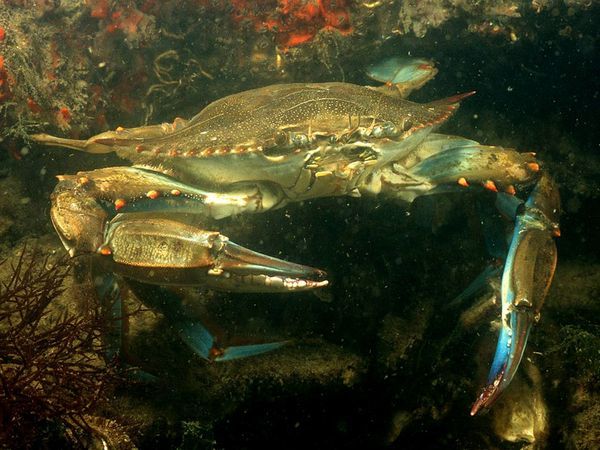Despite a harsh winter this year, the Chesapeake Bay’s blue crab population continues to make a comeback, government wildlife officials report.
This year’s annual winter dredge survey showed the blue crab population at its second-highest level since 1997, well above its target for a third year in a row. The survey estimated 461 million blue crabs currently in the Bay. That’s nearly double what it was in 2007, when population outlooks were very bleak.
A year after the population crisis in 2007, when crab numbers were estimated at only 249 million, Maryland, Virginia, and the Potomac River Fisheries Commission reduced harvest of female crabs by 34 percent.
Watermen in commercial crabbing from both states were ill-affected by the harvest limits, which combined with steeply rising fuel costs for a severe double shock on the regional crabbing industry.
Catch Limits Given Credit
“Today we continue to realize the benefits of the very tough decisions we made three years ago—decisions that are bringing us closer to our ultimate goal: a self-sustaining fishery that will support our industry and recreational fisheries over the long term,” Maryland Gov. Martin O’Malley (D) announced during an April 19 press conference.
Thomas Miller, interim director at the Chesapeake Biological Laboratory, said the protective measures to conserve females are clearly responsible for the recovery of Chesapeake Bay blue crabs.
“The evidence for that [connection] is both the direct response in increased abundance in females, but not males, and the fact that we only saw an increase in young crabs the following year after the females were preserved. Had it been just better overall environmental conditions, we would have expected females, males, and young crabs to all rise on the same tide. But because they didn’t, it speaks to the effectiveness of the female conservation measures that we put in place,” Miller said.
Progress Despite Harsh Winter
An unusually cold winter had the potential to wreak havoc on the crab population again. Maryland Department of Natural Resources Fisheries Director Tom O’Connell reported 31 percent of Maryland’s adult crabs were lost to winter kill, as opposed to 11 percent in 2010.
Steven G. Bowman, commissioner of the Virginia Marine Resources Commission, said in an April 19 press statement, “We cannot control the weather. It was a harsh winter and crab mortality was higher than normal. In fact, it was the worst we’ve seen since 1996. Thankfully, we acted when we did in 2008 to begin rebuilding the crab population, or the crab census results we see today would be grim indeed.”
Miller says two factors were responsible for the crabs’ demise during winter.
“There was a very sudden onset of cold temperatures. We’d been above average until mid-December, and then it cooled very, very rapidly in the space of about 10 days. And then it remained cold for the rest of the winter, unseasonably cold,” said Miller.
Second, “the rate of cooling this winter was much faster than typical, and the crabs couldn’t acclimate as quickly. So there was an acclimation issue at the beginning of winter. And then the duration of cold temperatures was also stressful,” Miller explained.
Restrictions Cautiously Loosened
The Maryland Department of Natural Resources (DNR) will take cautious measures to increase the commercial crab daily catch limits this year. DNR is increasing female catch limits between September 1 and November 10. Limited Crab Catcher License carriers will be allowed to land 12 bushels a day, an increase of two bushels over the same period last year.
Those are the only increases on commercial and recreational crabbing regulations for 2011. The commercial harvesting of female crabs remains prohibited between June 1 and June 15 and between November 11 and December 15.
“Clearly, we’re on the right path, and this drop in crab abundance just means it will take a bit longer to completely rebuild the stock,” Virginia Secretary of Natural Resources Doug Domenech told the press on April 19. “I’m heartened that, despite a large number of dead crabs due to the winter weather, the stock remains in better shape now than it has been at any point since 1997. Consumers should continue to enjoy crab cakes and crab soup. There are plenty of crabs.”
Alyssa Carducci ([email protected]) writes from Tampa, Florida.




